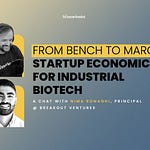Welcome to the 83rd edition of Deep Tech Catalyst, the channel from The Scenarionist where science meets venture!
If you've ever wondered why breakthrough agri-food innovations struggle to reach scale—or how to build an investable startup in one of the world’s most fragmented, regulated, and biologically complex markets—this episode will sharpen your view.
Today, we're joined by Sara Olson, Senior Director of Crop Science Venture Investments at Leaps by Bayer!
From lab-bench concepts to field-proven products, Sara shares what it really takes to turn a deep tech insight into a viable agri-business. We unpack the strategic choices founders must make, the signals investors look for, and why execution in this sector demands a rare blend of scientific rigor, regulatory fluency, and go-to-market realism.
In this edition, we explore:
Why agri-food is one of the hardest, highest-stakes markets to innovate in
What makes a crop technology investable—from early trials to EBITDA logic
How to choose between row crops and specialty markets—and why the decision shapes your entire roadmap
What techno-economic levers matter most for scaling—from production method to formulation
Why regulatory navigation is not a formality—but a design constraint baked into your product
Whether you're a founder building in agtech, an investor exploring biology-driven markets, or a scientist curious about commercial translation, this episode offers a front-row seat to how real innovation happens in the food system.
Let’s dig in 🌱
✨ For more, see Membership | Deep Tech Briefing | Insights | VC Guides
BEYOND THE CONVERSATION — STRATEGIC INSIGHTS FROM THE EPISODE
Understanding the Terrain: Why Agri-Food Is a High-Stakes Market
Agriculture doesn’t behave like other industries. It isn’t driven by taste, convenience, or trends. It’s an existential necessity—critical for human survival—and that reality shapes the way technologies are adopted, regulated, and monetized.
Because there is only one or two growing seasons per year, growers operate under unusually high stakes. A single season lost to a failed product isn’t a temporary inconvenience—it can represent a catastrophic financial hit.
In practice, that makes farmers highly skeptical of unproven innovations. A new solution must not just promise results—it must deliver under the real-world conditions of a working farm.
This isn’t a space where you can “fail fast.” There are no beta testers. Trust, once broken, is hard to rebuild. In turn, any startup trying to enter the market must recognize that technical success in the lab is just the starting line, not the finish.
Fragmentation, Regulation, and Complexity
On top of the inherent conservatism of the market, there’s extreme complexity. Crop agriculture is highly fragmented across geographies, crops, pests, and growing practices. What works in one region, with one crop, under one climate regime, may not generalize elsewhere. Each biological or environmental factor can change the outcome of an intervention.
This fragmentation has a direct impact on startup strategy. It makes scale-up harder. It increases the number of validation steps. And it raises the cost and time needed to prove broad efficacy.
Adding to that is regulatory scrutiny. Crop inputs must achieve a delicate balance: killing pathogens and pests without harming beneficial insects, degrading safely in the environment, and avoiding toxicity in the food supply. These aren’t edge-case scenarios—they’re baseline requirements. And the complexity only increases when you factor in evolving consumer demands, sustainability metrics, and shifting global regulations.
Yet despite these hurdles—or perhaps because of them—the opportunity remains enormous. The agri-food sector is one of the few areas where technological progress is deeply consequential. Done right, innovation here doesn’t just improve margins. It can improve lives, ecosystems, and the resilience of global food systems.
The Scientific Concept Is Only the Beginning
The origin of most agri-food tech startups is a scientific insight—an intriguing mechanism, a promising molecule, a biological interaction observed under controlled conditions. But while discovery is essential, it is only the first gate.
The hard part is turning that insight into something that works outside the lab.
Controlled environments are ideal for hypothesis testing but offer little indication of how a technology will behave in the real world. Sunlight, rainfall, wind, soil variability, microbial communities, and application methods all introduce variables that the lab can’t simulate. The leap from proof-of-concept to usable technology involves redesigning the entire system for environmental chaos, not precision control.
This step is often underestimated. It is where most early-stage agri-tech efforts stall. The product has to not only function in volatile field conditions but also retain stability, shelf life, and usability for farmers, who won’t tolerate complexity or fragility.
From Technology to Product
Once a technology shows potential in early field trials, the next challenge is packaging it into something a buyer understands and values. That transition—from technology to product—is not just about efficacy.
It’s about use case, positioning, and value communication.
The core questions become:
Will someone pay for this? (Not once, but repeatedly.)
What pain does it solve?
How does it compare to existing alternatives?
How easy is it to use in existing farm operations?
In this phase, the founder’s mindset must shift. The priority is no longer proving the technology works—it’s proving the product fits. That includes application method, timing, compatibility with farm equipment, and even labeling. Anything that adds friction becomes a barrier to adoption.
From Product to Business
Even if a product solves a clear problem and fits into a grower’s workflow, the journey isn’t over. Building a business means establishing reliable unit economics, understanding how to acquire and retain customers, and navigating a regulatory path to scale.
This includes determining whether production can meet demand at viable costs, whether distribution is feasible without incurring heavy burn, and whether the startup can eventually reach positive EBITDA margins in a notoriously margin-sensitive sector.
The path from lab bench to revenue is long—and it requires crossing multiple gates. Each one filters out a different type of risk. The companies that make it through are rarely those with the most elegant science. They’re the ones that learn, early and decisively, how to convert that science into value under real-world constraints.
What Makes a Company Investable in Crop Protection
In any deep tech sector, team quality is paramount. But in agri-food, that requirement goes further.
A strong team doesn’t just need scientific or technical chops—it needs system fluency. That means understanding farmers, distribution channels, trial logistics, regulatory nuance, and capital-efficient scaling.
Investors look closely at whether the founding team has the right to win.
What makes them uniquely suited—not just to build the technology, but to navigate the entire commercial terrain?
Do they have deep technical expertise paired with strategic awareness?
Do they know where their knowledge ends and where partnerships must begin?
The best teams don’t simply solve technical problems. They solve the commercial riddle of where, how, and why a product will be adopted.
Surfboards, Surfers, and Market Waves
A useful analogy frames the startup as a surfer (the team), riding a surfboard (the technology) on a market wave (the opportunity). In this view, a world-class team can do a lot even with imperfect technology, especially in a fast-moving market.
In agri-food, the wave doesn’t move fast. The market is massive, but slow to shift. That makes the quality of the surfboard and the discipline of the surfer even more important.
The opportunity is there, but it doesn’t wait for half-ready solutions. A credible team is one that not only understands this metaphor, but behaves accordingly—investing early in realistic trial plans, robust product development, and channel relationships that align with how the market actually works.
Milestones That Signal Maturity
For investors, milestones matter. In agri-tech, this often takes the form of increasingly complex and realistic trials. The path typically moves from highly controlled lab tests, to greenhouse environments and eventually to real-world field trials.
Each step introduces more variables—and higher credibility.
A startup that can show performance across multiple conditions, locations, or crop types earns more than technical validation. It earns market insight. These results begin to clarify which segment the product is best suited for, what economic value it delivers, and what regulatory path will be required.
Equally important is clarity around the problem being solved. Founders who pursue innovation for its own sake are less compelling than those who anchor their work in a clear, unmet need. Especially powerful is when that need is growing—due to regulation, resistance, climate shifts, or labor constraints—and when incumbents are poorly positioned to respond.
An investable company, in short, is one that connects the dots. It links technology to user behavior, user behavior to market dynamics, and market dynamics to long-term business construction. That narrative isn’t built from pitch decks. It’s built from evidence—and earned insight.
The Power Law of Matter: Why Advanced Materials are Eating Digital Margins
From SaaS Logic to Commodity Logic. From advanced materials in photonics to fusion energy — the real profit pools are moving back into the atomic layer.
Choosing the Right Crop Strategy: Two Markets, Two Playbooks
In crop agriculture, nearly every startup must eventually face a binary choice: should we go after broad-acre row crops or focus on high-value specialty crops?
This decision is not cosmetic—it determines everything from product design to pricing, regulatory path, and sales motion. While the boundary between these two markets can blur, especially at scale, early-stage companies rarely have the resources to serve both. And trying to do so often dilutes focus and impairs execution.
Understanding the tradeoffs is essential. Making a smart, grounded choice—and being able to articulate why—is one of the strongest signals of strategic maturity in a founding team.
Row Crops: Big TAM, High Barriers
Row crops (e.g., corn, soy, canola) represent enormous addressable markets. The total acreage is massive, and the number of growers operating at an industrial scale means that a single sales win can unlock thousands of acres. TAM numbers are enticing, and the path to scale, at least on paper, looks straightforward.
But the barriers are just as large. These markets are dominated by incumbent agrochemical companies with well-established distribution channels. Growers are cost-sensitive and unwilling to adopt new technologies unless the performance delta is unmistakable—and proven under real-world conditions.
The economics are tough. Inputs must work at very low cost per acre, with minimal added labor, and be compatible with existing application infrastructure. A startup targeting row crops must be prepared to meet all these thresholds while also delivering real ROI to growers who operate on razor-thin margins.
Yet for those who succeed, the upside is extraordinary. Row crops are where market share is measured in millions of acres, and where defensibility comes from validated performance, trusted brands, and scale-driven cost advantages.
Specialty Crops: Niche Markets, High Margins
By contrast, specialty crops (e.g., fruits, vegetables, berries, nuts) offer a different kind of opportunity. The total acreage is smaller, and the markets are more fragmented. But the economics per acre are often better. Growers in this segment are used to investing more heavily in crop protection and quality-enhancing inputs. Margins are higher, and tolerance for premium pricing can exist—especially when quality affects shelf life, taste, or visual appeal.
In some cases, startups choose this path because their technology addresses a narrow use case—a specific pest, pathogen, or stress response. In others, the choice is regulatory: some products can be brought to market faster under a biostimulant framework if claims are restricted to quality or resilience rather than explicit pest control.
Specialty crops can also offer a proving ground. A focused launch on one crop in one geography can generate early revenues, product feedback, and regulatory experience—all while conserving capital. That momentum can later be used to move into other crops or broader markets.
Investors want to see founders make a deliberate, data-driven choice.
The reason doesn’t have to be perfect—but it has to be coherent. Founders who say, “We’re going after both,” often signal a lack of commercial grounding.
The most compelling teams explain why they’re starting where they are—based on biology, regulatory timing, market structure, or margin dynamics. They know the limits of their own product, and they’ve chosen a starting point that plays to its strengths. That clarity becomes the foundation for everything that follows: trial design, pricing strategy, customer engagement, and capital deployment.
3 Levers That Shape Cost and Margin
In many sectors, financial modeling is a downstream concern. Not so in agri-food tech. Here, understanding the techno-economic profile of a product is essential from day one—even when the company has no revenue and only milligrams of a prototype in the lab.
That’s because agriculture operates on thin margins, seasonal cycles, and cost-per-acre benchmarks that are well understood by buyers. Founders must be able to articulate how their product might eventually hit a viable cost point—not precisely, but directionally. Without that, even the most promising technology risks becoming commercially irrelevant.
Investors aren’t asking for certainty. They’re asking for fluency:
Can the team describe which variables drive cost, and which of those are adjustable?
Do they understand how formulation, dosage, and production method interact
Can they explain where the economic inflection points are likely to be?
Lever 1: Production Method
How a product is made defines its economic potential. Is it chemically synthesized, biologically fermented, or extracted from a plant or microbe?
Each method has different implications for cost, scale-up complexity, and supply chain resilience.
In early-stage projects, production costs are often too high—but that’s not disqualifying. What matters is whether there's a clear path to reducing those costs over time:
Could purity requirements be relaxed?
Can fermentation yields improve?
Are there cheaper feedstocks or different organisms that can express the active?
Savvy founders think in terms of constraints and levers. They understand what’s intrinsic to the molecule and what’s subject to engineering and optimization.
Lever 2: Dosage and Application
The second lever is how much of the product is needed to treat one acre. A molecule might be inexpensive in raw form but require high application rates to be effective—undermining its viability in large-scale agriculture.
Reducing dosage isn’t just about potency. It's about timing, precision, and compatibility:
Could the product be delivered through an existing system?
Could timing be adjusted to improve impact per unit?
Could synergy with other inputs reduce the total volume required?
Every reduction in application rate improves logistics, reduces transport costs, and eases adoption. For investors, this is a key area of focus—because it speaks to commercial scalability, not just scientific performance.
Lever 3: Formulation and Stability
Formulation is where chemistry meets usability. A product that degrades quickly in sunlight or rain may be effective in theory but useless in practice. Conversely, a stable formulation that protects the active ingredient and ensures even delivery can multiply efficacy and reduce waste.
Formulation can also influence shelf life, packaging, and distribution—critical variables in rural and global markets. Encapsulation, carrier selection, or adjuvant integration all play a role.
A well-formulated product not only performs better but simplifies compliance, shipping, and application—each of which lowers cost and raises adoption probability.
The Real Metric: Cost in Use
Ultimately, the metric that matters is not cost of production—it’s cost in use. That includes dosage, delivery efficiency, formulation losses, and real-world efficacy. Two products with similar COGS can perform very differently when applied at scale.
Founders who understand this—and can model the key drivers of cost in use—position themselves as credible, investable, and strategically aware.
The Regulatory Challenge: Knowing Your Path from Day One
In agri-food tech, regulation isn’t something that happens after the product is built—it’s something that defines how the product must be built. From the earliest stages of R&D, founders need to think about their regulatory path not as a series of bureaucratic steps, but as a strategic constraint that shapes trial design, claims, timelines, and even funding milestones.
This is particularly true in sectors like crop protection, where approval is required not only to sell a product but even to run certain types of field trials. Misunderstanding this process can derail timelines, delay market entry by years, and erode investor confidence.
The most sophisticated teams integrate regulatory strategy into product design from day one. They know which agency they’ll need to engage, what kinds of data will be required, and how long each phase might take. This foresight doesn’t just smooth the process—it creates real competitive advantage.
The U.S. Landscape: EPA, USDA, and FDA
In the United States, three primary agencies govern agri-food innovation:
The Environmental Protection Agency (EPA) evaluates environmental impacts—particularly on non-target species like bees, birds, and aquatic life. Any product claiming pest control must go through this pathway, with data on eco-toxicology, persistence, and exposure.
The U.S. Department of Agriculture (USDA) focuses on how a product interacts with the crop or livestock system. That includes field trial regulations, import/export controls, and biotech oversight.
The Food and Drug Administration (FDA) gets involved if the product—or its residues—enters the food chain. This is particularly relevant for ingredients, processing aids, or any input that may affect human consumption.
Most startups will interact with at least two of these bodies at some point. Some will touch all three. Understanding how their jurisdictions overlap is crucial.
The EU System: Different Names, Same Challenges
In the European Union, the system looks slightly different but follows a similar logic. The European Commission governs what can be used and where, while the European Food Safety Authority (EFSA) evaluates food-related safety. The complexity often increases due to national-level interpretation of EU-wide regulations.
For companies operating transatlantically, this means planning for multiple regulatory pathways from the outset—each with its own datasets, definitions, and timelines. Products may qualify as crop protection in one jurisdiction and biostimulants in another, with major implications for commercialization strategy.
Experts Are Not Optional
For early-stage teams, the best decision is often the simplest: bring in regulatory expertise early. Not as an afterthought, but as a partner in product and trial design.
The right expert can help map the path from lab to label—advising on what claims to make, what studies to run, and what endpoints regulators will prioritize. This expertise saves time, capital, and credibility. More importantly, it helps founders avoid the trap of building a product that can’t legally go to market—or one that requires a prohibitively expensive approval process.
As in MedTech or pharma, the regulatory burden is heavy—but it is also well-structured and navigable with the right guidance. Knowing the map early is one of the clearest signals to investors that a team is serious, grounded, and ready to build in the real world.
DON’T MISS OUR LATEST BRIEFING:
🤖AI Chips-as-Collateral Emerge; ⚡Weather Engineered by AI; 🧠Claude Enters the Military Stack; 💨Carbon Capture Goes Maritime; ⚛️Fusion Shifts from Theory to Territory | Deep Tech Briefing #70
Weekly Intelligence on Deep Tech Startup and Venture Capital. Every Sunday, we curate and analyze the most relevant startup advancements, VC trends, and industry shifts you need to know—if you want to lead!













